现在分词作状语
- 格式:docx
- 大小:32.05 KB
- 文档页数:34
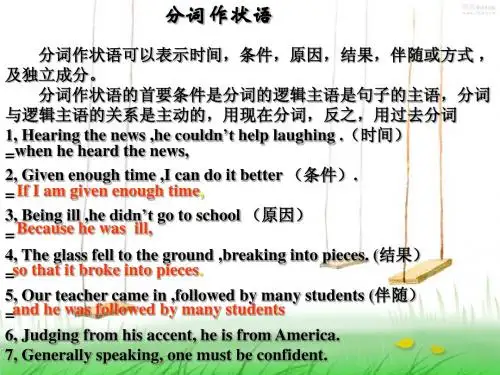
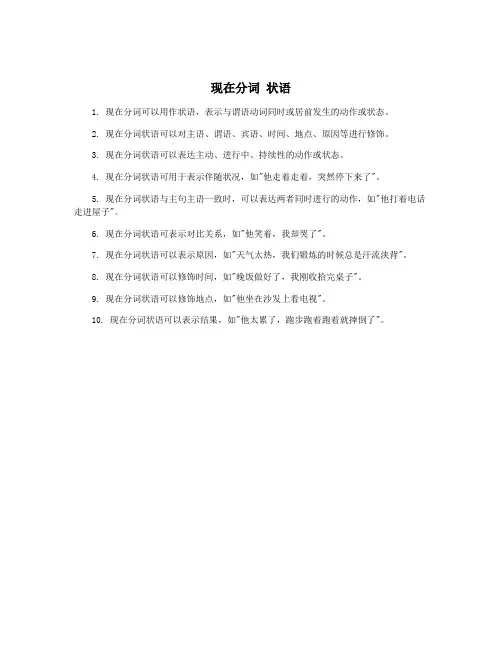
现在分词状语
1. 现在分词可以用作状语,表示与谓语动词同时或居前发生的动作或状态。
2. 现在分词状语可以对主语、谓语、宾语、时间、地点、原因等进行修饰。
3. 现在分词状语可以表达主动、进行中、持续性的动作或状态。
4. 现在分词状语可用于表示伴随状况,如"他走着走着,突然停下来了"。
5. 现在分词状语与主句主语一致时,可以表达两者同时进行的动作,如"他打着电话走进屋子"。
6. 现在分词状语可表示对比关系,如"他笑着,我却哭了"。
7. 现在分词状语可以表示原因,如"天气太热,我们锻炼的时候总是汗流浃背"。
8. 现在分词状语可以修饰时间,如"晚饭做好了,我刚收拾完桌子"。
9. 现在分词状语可以修饰地点,如"他坐在沙发上看电视"。
10. 现在分词状语可以表示结果,如"他太累了,跑步跑着跑着就摔倒了"。
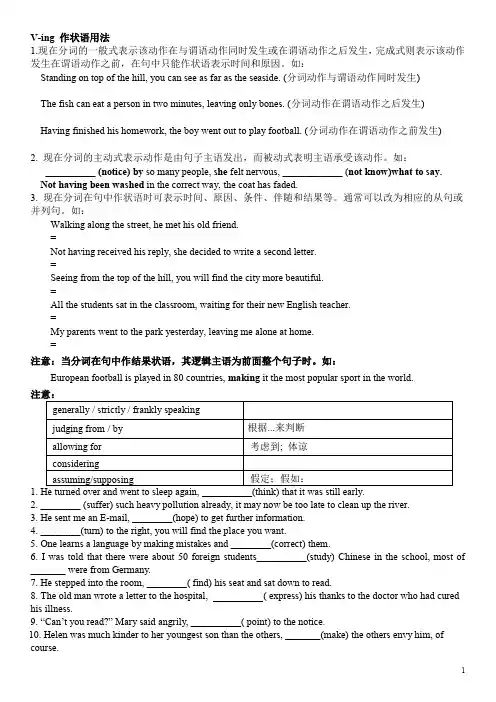
V-ing 作状语用法1.现在分词的一般式表示该动作在与谓语动作同时发生或在谓语动作之后发生,完成式则表示该动作发生在谓语动作之前,在句中只能作状语表示时间和原因。
如:Standing on top of the hill, you can see as far as the seaside. (分词动作与谓语动作同时发生)The fish can eat a person in two minutes, leaving only bones. (分词动作在谓语动作之后发生)Having finished his homework, the boy went out to play football. (分词动作在谓语动作之前发生)2.现在分词的主动式表示动作是由句子主语发出,而被动式表明主语承受该动作。
如:__________ (notice) by so many people, she felt nervous, ____________ (not know)what to say.Not having been washed in the correct way, the coat has faded.3.现在分词在句中作状语时可表示时间、原因、条件、伴随和结果等。
通常可以改为相应的从句或并列句。
如:Walking along the street, he met his old friend.=Not having received his reply, she decided to write a second letter.=Seeing from the top of the hill, you will find the city more beautiful.=All the students sat in the classroom, waiting for their new English teacher.=My parents went to the park yesterday, leaving me alone at home.=注意:当分词在句中作结果状语,其逻辑主语为前面整个句子时。


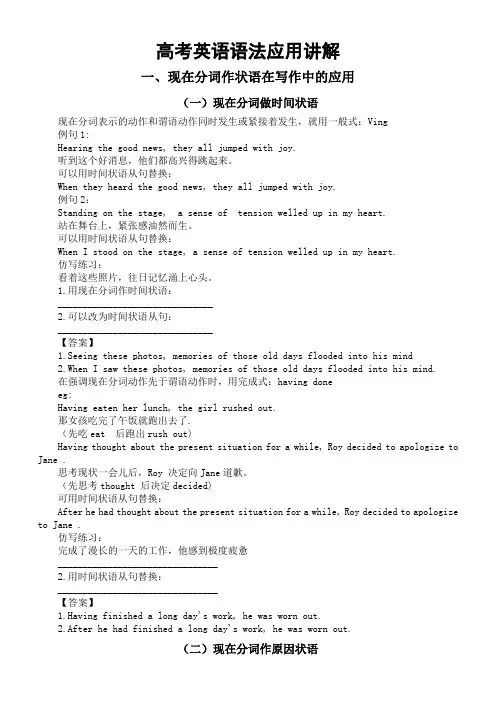
高考英语语法应用讲解一、现在分词作状语在写作中的应用(一)现在分词做时间状语现在分词表示的动作和谓语动作同时发生或紧接着发生,就用一般式:Ving例句1:Hearing the good news, they all jumped with joy.听到这个好消息,他们都高兴得跳起来。
可以用时间状语从句替换:When they heard the good news, they all jumped with joy.例句2:Standing on the stage, a sense of tension welled up in my heart.站在舞台上,紧张感油然而生。
可以用时间状语从句替换:When I stood on the stage, a sense of tension welled up in my heart.仿写练习:看着这些照片,往日记忆涌上心头。
1.用现在分词作时间状语:_______________________________2.可以改为时间状语从句:_______________________________【答案】1.Seeing these photos, memories of those old days flooded into his mind2.When I saw these photos, memories of those old days flooded into his mind.在强调现在分词动作先于谓语动作时,用完成式:having doneeg:Having eaten her lunch, the girl rushed out.那女孩吃完了午饭就跑出去了.(先吃eat 后跑出rush out)Having thought about the present situation for a while, Roy decided to apologize to Jane .思考现状一会儿后,Roy 决定向Jane道歉。
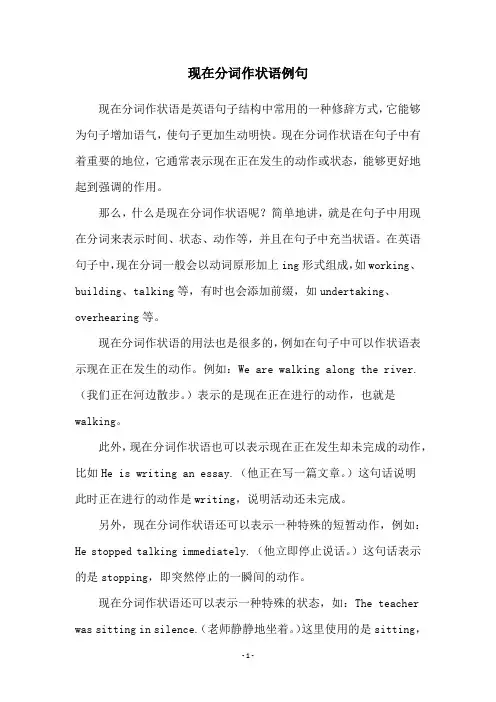
现在分词作状语例句现在分词作状语是英语句子结构中常用的一种修辞方式,它能够为句子增加语气,使句子更加生动明快。
现在分词作状语在句子中有着重要的地位,它通常表示现在正在发生的动作或状态,能够更好地起到强调的作用。
那么,什么是现在分词作状语呢?简单地讲,就是在句子中用现在分词来表示时间、状态、动作等,并且在句子中充当状语。
在英语句子中,现在分词一般会以动词原形加上ing形式组成,如working、building、talking等,有时也会添加前缀,如undertaking、overhearing等。
现在分词作状语的用法也是很多的,例如在句子中可以作状语表示现在正在发生的动作。
例如:We are walking along the river.(我们正在河边散步。
)表示的是现在正在进行的动作,也就是walking。
此外,现在分词作状语也可以表示现在正在发生却未完成的动作,比如He is writing an essay.(他正在写一篇文章。
)这句话说明此时正在进行的动作是writing,说明活动还未完成。
另外,现在分词作状语还可以表示一种特殊的短暂动作,例如:He stopped talking immediately.(他立即停止说话。
)这句话表示的是stopping,即突然停止的一瞬间的动作。
现在分词作状语还可以表示一种特殊的状态,如:The teacher was sitting in silence.(老师静静地坐着。
)这里使用的是sitting,表示的是老师此时正在保持安静的状态。
最后,现在分词作状语还可以表示一种持续性的状态,例如:The girl is wearing a red dress.(这个女孩穿着一件红色的连衣裙。
)表示的是wearing,即长时间持续一段时间的状态。
综上所述,现在分词作状语在英语句子中起到至关重要的作用,它能够为句子增加语气,使句子更加生动明快,使句子更加有力。
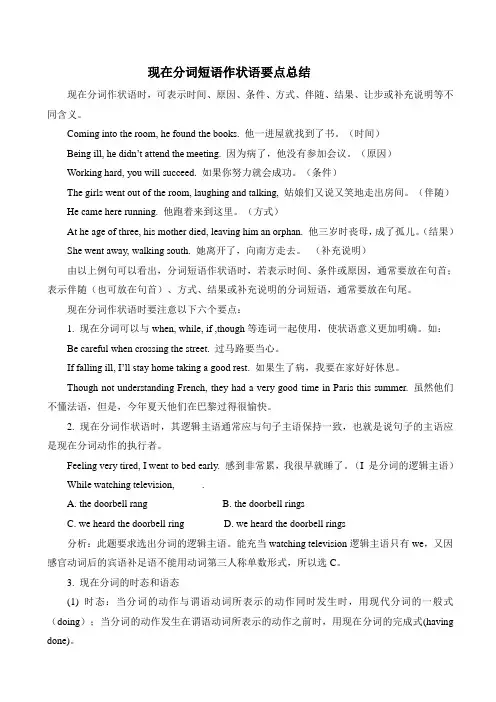
现在分词短语作状语要点总结现在分词作状语时,可表示时间、原因、条件、方式、伴随、结果、让步或补充说明等不同含义。
Coming into the room, he found the books. 他一进屋就找到了书。
(时间)Being ill, he didn’t attend the meeting. 因为病了,他没有参加会议。
(原因)Working hard, you will succeed. 如果你努力就会成功。
(条件)The girls went out of the room, laughing and talking, 姑娘们又说又笑地走出房间。
(伴随)He came here running. 他跑着来到这里。
(方式)At he age of three, his mother died, leaving him an orphan. 他三岁时丧母,成了孤儿。
(结果)She went away, walking south. 她离开了,向南方走去。
(补充说明)由以上例句可以看出,分词短语作状语时,若表示时间、条件或原因,通常要放在句首;表示伴随(也可放在句首)、方式、结果或补充说明的分词短语,通常要放在句尾。
现在分词作状语时要注意以下六个要点:1. 现在分词可以与when, while, if ,though等连词一起使用,使状语意义更加明确。
如:Be careful when crossing the street. 过马路要当心。
If falling ill, I’ll stay home taking a good rest. 如果生了病,我要在家好好休息。
Though not understanding French, they had a very good time in Paris this summer. 虽然他们不懂法语,但是,今年夏天他们在巴黎过得很愉快。
2. 现在分词作状语时,其逻辑主语通常应与句子主语保持一致,也就是说句子的主语应是现在分词动作的执行者。
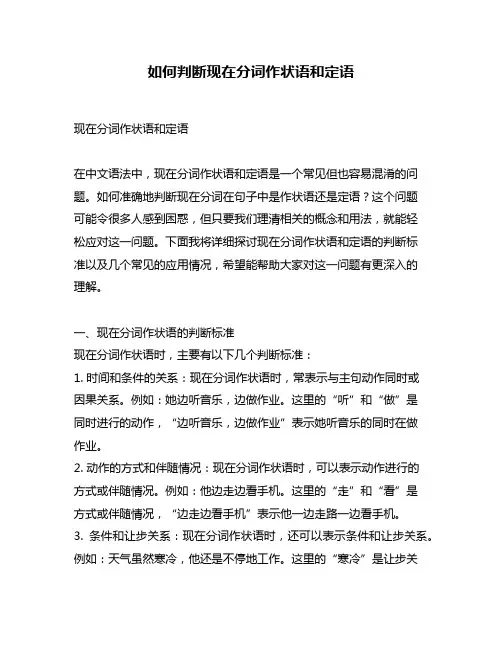
如何判断现在分词作状语和定语现在分词作状语和定语在中文语法中,现在分词作状语和定语是一个常见但也容易混淆的问题。
如何准确地判断现在分词在句子中是作状语还是定语?这个问题可能令很多人感到困惑,但只要我们理清相关的概念和用法,就能轻松应对这一问题。
下面我将详细探讨现在分词作状语和定语的判断标准以及几个常见的应用情况,希望能帮助大家对这一问题有更深入的理解。
一、现在分词作状语的判断标准现在分词作状语时,主要有以下几个判断标准:1. 时间和条件的关系:现在分词作状语时,常表示与主句动作同时或因果关系。
例如:她边听音乐,边做作业。
这里的“听”和“做”是同时进行的动作,“边听音乐,边做作业”表示她听音乐的同时在做作业。
2. 动作的方式和伴随情况:现在分词作状语时,可以表示动作进行的方式或伴随情况。
例如:他边走边看手机。
这里的“走”和“看”是方式或伴随情况,“边走边看手机”表示他一边走路一边看手机。
3. 条件和让步关系:现在分词作状语时,还可以表示条件和让步关系。
例如:天气虽然寒冷,他还是不停地工作。
这里的“寒冷”是让步关系,“天气虽然寒冷”表示尽管天气寒冷,他还是不停地工作。
二、现在分词作定语的判断标准现在分词作定语时,主要有以下几个判断标准:1. 逻辑主语的确定:现在分词作定语时,需要确定它所修饰的名词或代词,即逻辑主语。
例如:她穿着一身红色的连衣裙。
这里的“红色的连衣裙”中的“红色的”就是现在分词作定语修饰的名词“连衣裙”,即“红色的”说明了“连衣裙”的颜色。
2. 定语的限定性:现在分词作定语时,通常用于限定被修饰名词的范围或描述名词特征。
例如:一群欢笑的孩子。
这里的“欢笑的”说明了孩子的状态或特征。
3. 定语与被修饰词的关系:现在分词作定语时,需要注意它和被修饰词的逻辑关系,通常是名词的属性或特征。
例如:周围响起了嬉笑声。
这里的“嬉笑”是现在分词作定语修饰名词“声”,表示了声音的特征。
我们可以通过以上几个判断标准来准确地判断现在分词是作状语还是定语。
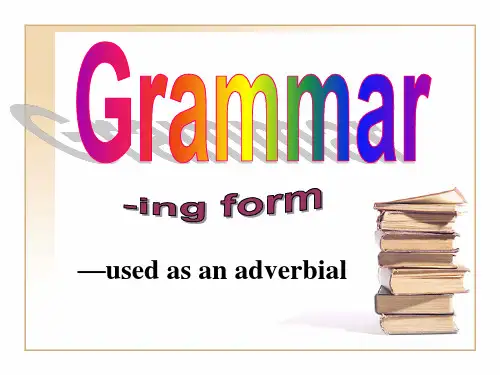
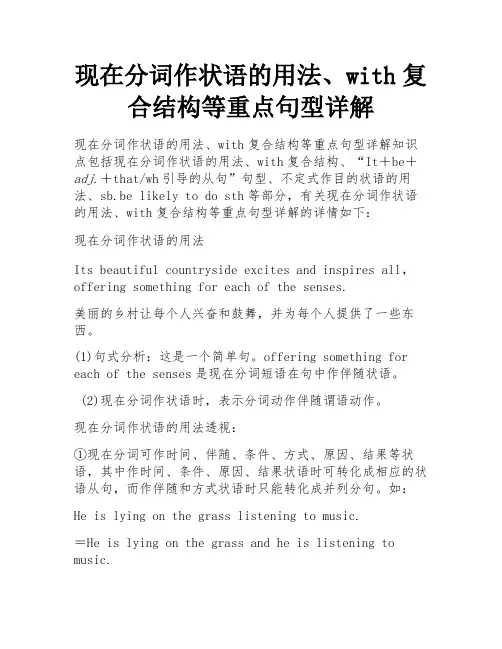
现在分词作状语的用法、with复合结构等重点句型详解现在分词作状语的用法、with复合结构等重点句型详解知识点包括现在分词作状语的用法、with复合结构、“It+be+adj.+that/wh引导的从句”句型、不定式作目的状语的用法、sb.be likely to do sth等部分,有关现在分词作状语的用法、with复合结构等重点句型详解的详情如下:现在分词作状语的用法Its beautiful countryside excites and inspires all,offering something for each of the senses.美丽的乡村让每个人兴奋和鼓舞,并为每个人提供了一些东西。
(1)句式分析:这是一个简单句。
offering something for each of the senses是现在分词短语在句中作伴随状语。
(2)现在分词作状语时,表示分词动作伴随谓语动作。
现在分词作状语的用法透视:①现在分词可作时间、伴随、条件、方式、原因、结果等状语,其中作时间、条件、原因、结果状语时可转化成相应的状语从句,而作伴随和方式状语时只能转化成并列分句。
如:He is lying on the grass listening to music.=He is lying on the grass and he is listening to music.他躺在草地上,听音乐。
(形容词)Walking in the street (=When/While I was walking in the street), I saw him.我在街上散步时看见了他。
(时间状语)Being spring (=As/Since it is spring), the flowers are in full bloom.春天到了,鲜花盛开。
(原因状语)②现在分词的逻辑主语与句子主语一致,且 doing 表示 do 与其逻辑主语之间是主谓关系;being done 表示 do 与其逻辑主语之间是动宾关系;若分词动作发生在谓语动作之前,则用完成式 having done;若表示被动和完成,则用 having been done。
如何判断现在分词作状语和定语
现在分词可以作为状语或定语来修饰句中的名词或代词。
下面是判断现在分词作状语和定语的几个方法:
1. 作状语的现在分词一般表示主动或正在进行的动作,与句子的主语存在逻辑上的主谓关系。
这种现在分词可以回答疑问词"how?", "in what way?",或者解释动作发生的时间、原因、目的等。
例如:- He left the room, smiling.(状语,回答"in what way?")
- The teacher explained the grammar point, using simple examples.(状语,回答"how?")
2.作定语的现在分词用来修饰名词或代词,相当于一个形容词短语。
这种现在分词一般放在被修饰的名词或代词之前,修饰该名词或代词表达的人或事物的属性、特征等。
例如:
- The girl standing over there is my sister.(定语
- We saw a running dog in the park.(定语,修饰a dog)
总之,根据现在分词与句子主语的关系、回答的问题以及它对名词或代词的修饰方式,可以判断现在分词是作状语还是定语。
现在分词作状语 教学目标:讲解现在分词作状语及区分不定式、现在
分词作状语的异同
重点难点: 1. 现在分词和不定式作状语时, 其逻辑主语一般应与句子的主语 保持一致。
2. 分词作状语时, 要看它同句子主语之间的关系, 以确定是现在 分词还是过去分词。
3. 注意非谓语动词与句子谓语动词的时间关系, 以确定分词的时 态形式
4、弄清非谓语动词与其逻辑主语的关系,以确定非谓语动词的 语态形式 .
5. 连词 +分词形式(分词作状语的省略问题) 6. 不定式作结果状语和现在分词作结果状语的区别。 7. 现在分词的独立主格结构和评价性状语
Step 1 lead in 现在分词作状语 朗读下面一首 xx,找出其中的现在分词形式
Thinking in the Silent Night Before my bed there is bright moonlight So that it seems that frost on the ground. 疑是地上霜 Lifting my head, I watch the bright moonlight. 举头 xx Lowering my head, I dream that I 'm home.低头思故乡 Step2 现在分词作状语的意义 动词的现在分词作状语,修饰动词,相当于状语从句,在句中表 示时间、原因、结果、条件、让步、行为方式或伴随情况及独立成分 等,作时间、原因、条件、让步状语时多位于句首;作结果、伴随情 况状语时常位于句末。
一. -ing 分词短语作时间状语,代替一个时间状语从句 (引导词 有 when ,while )
xx 提示: 1.现在分词所表示的动作与主句的动作一般是同时发生,有时 可由连词 when, while 引出。
2.现在分词所表示的动作一发生,主句的动作就立即发生时。 如:
静夜思 床前 xx 现在分词作状语 Whens he saw those pictures ,she remembered her childhood.
=Seeing those pictures, she remembered her childhood. 看 到那些画,她想起了自己的童年。
As soon as he heard the good news, he jumped with joy. =(0n) Hearing the good news, he jumped with joy. 他一听到这个好消息,就高兴地跳起来。 二.-ing 分词短语作原因状语,相当于一个原因状语从句。 ( 引 导词有 because ,as ,since)
如: As he was ill, he didn't go to school yesterday =Being ill, he didn't go to school yesterday. 由于生病, 他昨天没有上学。
三. -ing 分词也可作条件状语和让步状语,相当于一个条件状 语从句。 ( 引导词有 if,unless,once)
If you work hard, you will succeed. =Working hard, you will succeed. 如果你勤奋一点,你就会成功。 If you turn to the left, you will find the path leading to the school. 现在分词作状语 =Turning to the left, you will find the path leading to the school.
如果你 xx ,你就会找到到学校取得路。 四.表示让步,相当于让步状语从句(引导词有 although,though,even if ,even though )
Although they knew all this ,they madem ep ay for the damage.
= Knowing all this, they made me pay for the damage. 尽 管知道了一切情况,他们还是要我赔偿损失。
五.现在分词可以做方式状语、伴随状语,表示行为方式、伴随 情况或补充说明,是主语的另一个、较次要的动作,相当于一个由 and 引导的并列结构。
She came into the house,and carried a lot of books. =She came into the house, carrying a lot of books. 她捧 着许多书走进了房间。
He lay on the grass, and stared at the sky for a long time.
=He lay on the grass, staring at the sky for a long time. 现在分词作状语 他躺在草地上,长时间地望着天空
xx 提示:伴随状语出现的条件是由一个主语发出两个动作或同 一个主语处于两种状态, 或同一个主语发出一个动作时又伴随有某一 种状态。
六.现在分词表示主句的动作所带来的必然结果, 相当于一个并 列谓语
His father died, and left him a lot of money. =His father died, leaving him a lot of money. 他父亲死 了,留给他许多钱。
She was so angry that she threw the toy on the ground, and broke it into pieces.
=She was so angry that she threw the toy on the ground, breaking it into pieces.
她非常生气,把玩具扔在地上,摔成了碎片。
Step 2 考点解读 分词作状语应注意的问题 A. 分词作状语的首要条件是分词的逻辑主语是句子的主语。 动词的分词形式作状语时, 其逻辑主语一般应与句子的主语保持 现在分词作状语 一致。 Entering the classroom, I found nobody in it. 走进教室, 我发现里面没人。(entering 的逻辑主语是 I ,相当于 whenI entered the classroom, I found nobody in it. )
如分词表示的动作不是句中主语发出或承受的,那就是误用。 课堂巩固练习:判断下列句子正误 1. 从窗户看出去,我们看见一个漂亮的花园。 a. Looking out through the window, the garden was beautiful.
b. Looking out through the window, we saw a beautiful garden.
2. 我看着晚报的时候,一只狗开始叫起来。 a. Reading the evening newspaper, a dog started barking. b. I was reading the evening newspaper when a dog started barking.
3. 听到这个消息,我的眼泪忍不住流下来。 a. Hearing the news, tears ran down her face. b. Hearing the news, she cried out sadly. 现在分词作状语 4. 等公汽的时候,一块砖头砸在我的头上。 a. waiting for the bus , a brick fell on my head. b.waiting for the bus ,I was hit by a brick on the head. 5. 打开窗户,一只蝴蝶飞进来了。 a. Opening the window, a butterfly flew into my room. b. Opening the window, I saw a butterfly flying into
6. 如果你努力学习,你的梦想一定会实现。 a.Working hard with a strong will, your dream will certainly come true
b.Working hard with a strong will, you'll certainly make your dream come true
B. 独立结构 分词的逻辑主语如不能和句子中的主语保持一致,该 -ing 形式 必须有自己的逻辑主语,通常有名词或代词来担任 , 成为独立主格结 构,独立结构可以表示伴随动作或情况 , 表示时间、原因、条件等。
但要注意主格词和主句的主语不能表示同一概念, 主格词和分词
my room. 现在分词作状语 的动作是主谓关系结构是: 形式:主格词 +doing 主格词+being +adj there being +n, 辨别正误 因为天气好,我们下周将举行运动会。 a. Being fine, we will have the sports meeting next week. b. It being fine, we will have the sports meeting next week.
练习:把下面句子改成独立主格形式 1.If the weather permits, we ' ll go out on an outing. =Weather permitting, we 'll go out on an outing. 天气 xx 的话,我们就去郊游。 2. Because it is Sunday, we needn't go to school. =It being Sunday, we needn't go to school. 因为是星期天,我们不需要上学。